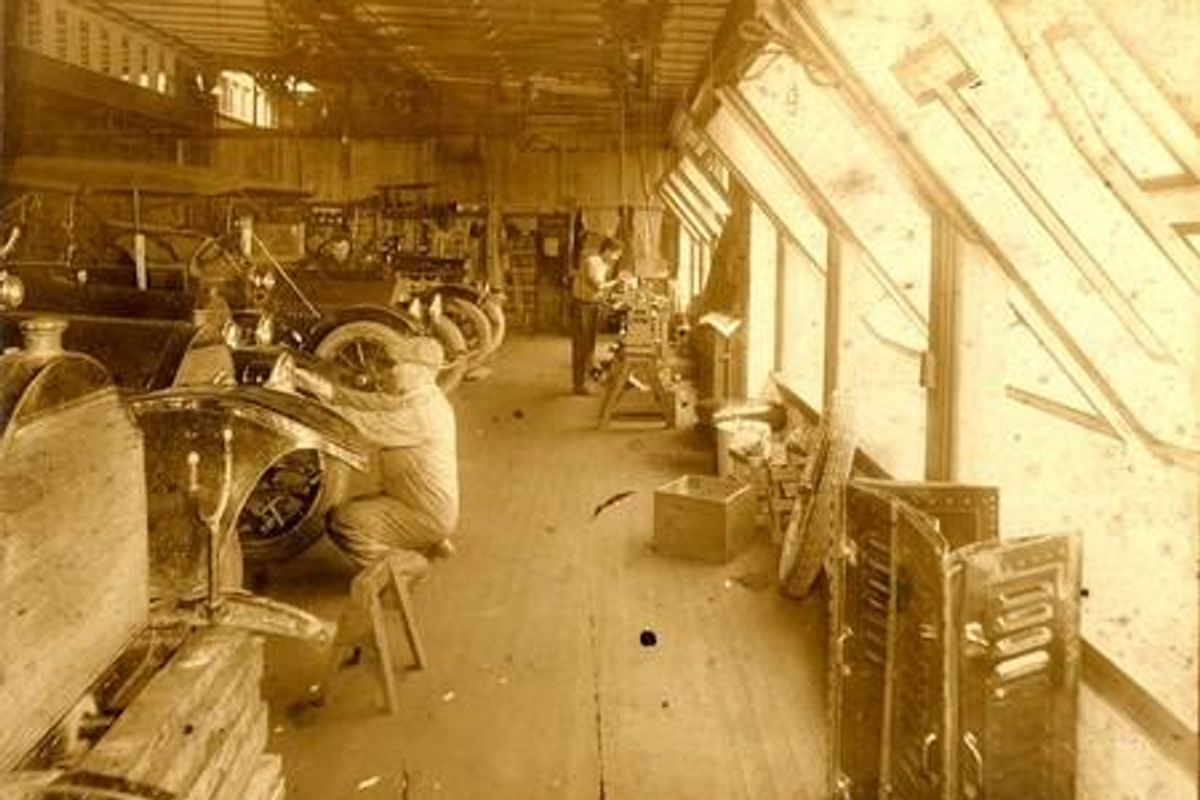With all this talk of Fiat buying Chrysler and coming to the United States, it bears mentioning that Fiat was already once here and even had an assembly plant in Poughkeepsie, New York, a stone's throw from the Hudson River: Fiat incorporated in the United States in 1908 and built its plant two years later.
The venture lasted less than a decade, but according to the Hudson Valley Ruins website, the factory remained in Poughkeepsie, first inhabited by Western Publishing, then by the Mid-Hudson Business Park and nearby Marist College in the 1980s before it was abandoned. Hudson Valley Ruins claims that after the factory's demolishing, the site now hosts a Staples store, but Associate Editor Mark McCourt, who hails from the mid-Hudson area, notes
The Fiat building was near the plaza where the Home Depot went up, but it wasn't the exact same place. I used to drive by this building every day on my way to Dutchess CC (I had no idea of its history until I came here), and it was directly across from the southern portion of the Marist college campus. A strip mall and student housing condos are now in that area.
And based on his recollections, we can narrow it down to a better view of where the factory once stood. Mark said he believes the factory was torn down in the late 1990s.
The reason for this little history lesson, however, lies with a recent email from reader Kim Morris, who sent the above photo and postcard and wondered if the photo was taken inside that Fiat factory.
You can see the stylized "A" in the window and the cars appear to be about 1913 Fiats. The windows also look right from the exterior photos I have seen of the plan, also attached.
That's very much the possibility, Kim.
UPDATE (11.June 2009): Tim Lavery confirmed with the Dutchess County Historical Society that the plant was located on the northeast corner of Rt. 9 and Fulton.
On the suggestion of a friend, I checked out Google Earth, which offers historic maps, and in their 1995 map of the region, it looks like the building's still standing:
UPDATE (24.September 2009): More on the factory here.
UPDATE (1.December 2009): Came across an interesting tidbit in the Standard Catalog. Apparently, when Fiat packed their bags, they sold the factory to the Duesenberg Motors Corporation, which bought it solely for the machinery, which they promptly moved to their Elizabeth, New Jersey, factory. So far I've yet to confirm that in any of our Duesenberg literature.
Market Snapshot: Jaguar E-type Showing Resilience and Growth Across All Three Series
Much has been written about Jaguar’s era-defining sports car, the E-type, or as it’s better known here in the U.S., the XKE. Long, low, lean, undeniably beautiful and among the fastest, quickest and best-handling cars of its day, the E-type struck a chord from the day it was introduced. From performance to innovation to design, it was a grand slam for Jaguar—or whatever the cricket equivalent is.
As the E-type was in development in the late Fifties, Jaguar was ahead of the curve of most other manufacturers. With design and engineering proven on the racetrack, the Coventry-based company most famously won the 24 Hours of Le Mans five times between 1951 and 1957. Just as Detroit was getting comfortable with OHV V8 engines, Jaguar was perfecting its DOHC inline-six with a twice-around-the-clock, flat-out race of attrition that it frequently won. Jaguar pioneered the use of disc brakes at Le Mans and soon after it became standard kit on its sports cars and sedans. Rack-and-pinion steering, fully independent suspension with coil springs, and a unit-body/monocoque chassis were additional technologies engineered into the E-type.

1963 Jaguar E-type Series 1 Open Two-Seater
Three Distinct Series
The XKE was a legitimate threat to breach the 150-mph barrier in stock form, at a time when three-digit speeds from street cars were a rarity, not the norm. Clearly an important car in British motoring history, the E-type proved popular in its primary market of North America. On the 50th anniversary of the model’s 1961 introduction, Jaguar shared that of some 72,520 total XKEs produced, 37,694 were sold in the U.S. and Canada. Those 72,000-plus cars are divided into three distinct series, all of which carry different weight with collectors.
Series 1 E-types are those built from 1961 through the end of the 1968 model year. Originally equipped with a 3.8-liter XK DOHC inline-six, the Series 1 received a power boost with a 4.2-liter version of the engine from 1965 on. The earliest cars have features like external hood latches, welded hood louvers and what is known as a “flat floor,” which refers to the tight spaces in the footboxes. Stamped hood louvers along with an in-cabin hood release soon followed, as did a modified floor with more space for driver's and passenger's feet A fully synchronized four-speed manual became standard for 1964. Thin bumpers, toggle switches on the dashboard and covered headlamps are signature elements of Series 1 cars.
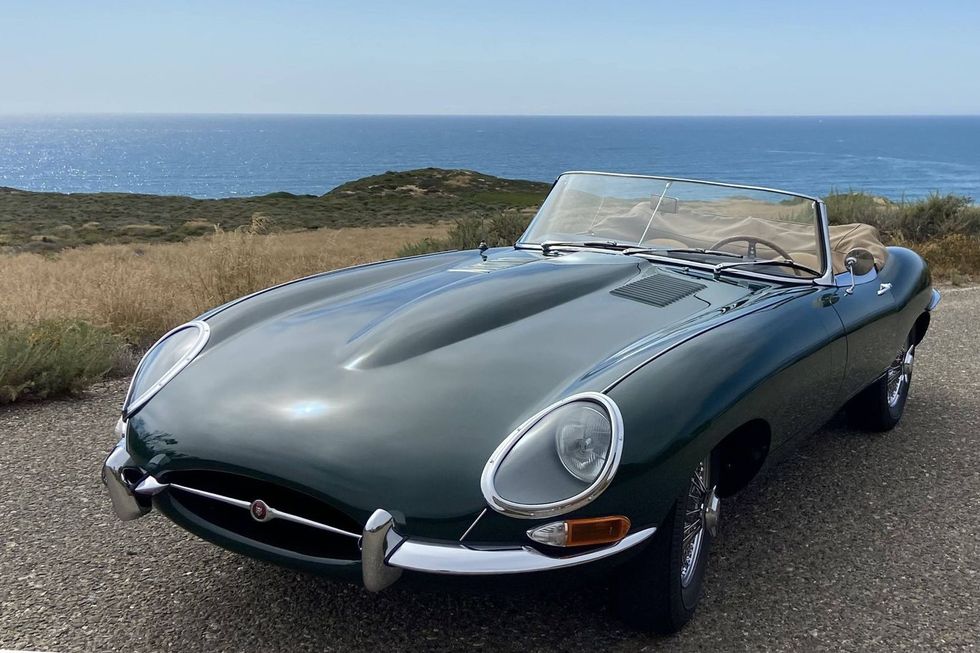
Covered headlamps were a signature design element of Series 1 E-types, as seen on this 1963 Open Two-Seater.
With the advent of the Federal Motor Vehicle Safety Standards for the 1968 model year, Jaguar introduced some changes to the Series 1 cars for the North American market only. Gone were the covered headlamps. Toggle switches were replaced with rocker switches, the door panels and steering wheel were redesigned and there were even some changes under the hood. In place of triple SU carburetors, Series 1.5 E-types were fitted with a pair of Zenith-Stromberg units to meet the earliest U.S. emissions standards. Output dropped by 20 horsepower from 1967 to 1968.
The 1969 model year saw the introduction of the E-type Series 2, which included a revised body for all world markets, with uncovered headlamps that were moved forward a bit, a wider opening for the grille on the front end and a wrap around, rather than split, rear bumper. Turn signals were larger, too. Inside, the rocker switches became a worldwide standard and headrests were added to the bucket seats. A longer, higher and heavier 2+2 body style was added to the standard Fixed-Head Coupe and Open Two-Seater models.
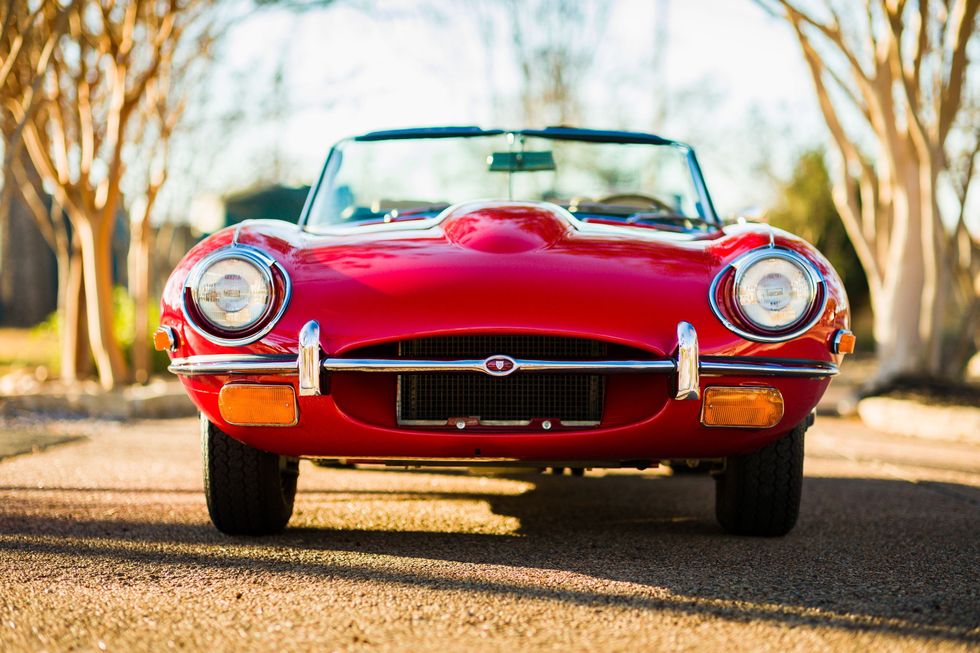
The front end of this 1969 E-type OTS shows the revised headlamp configuration, wider oval opening, and larger amber turn signals mounted below the bumper that were part of the changes incorporated into the Series 2 models.
The final version of the XKE, known as the Series 3, included the biggest change. In place of the cast-iron, twin-cam inline-six, Jaguar installed an aluminum-alloy SOHC V12 engine, which restored some of the performance lost to emissions controls, though by the Series 3 introduction in 1971, the E-type was heavier and more of a GT than an outright sports car. Along with the adoption of the bigger engine, Jaguar designed an even larger oval air intake with an eggcrate grille. The two-seat coupe was exorcised from the lineup, with the just the convertible and 2+2 models remaining for the Series 3. Wheel arch flares to accommodate larger rubber and larger bumper overriders were also part of the package.
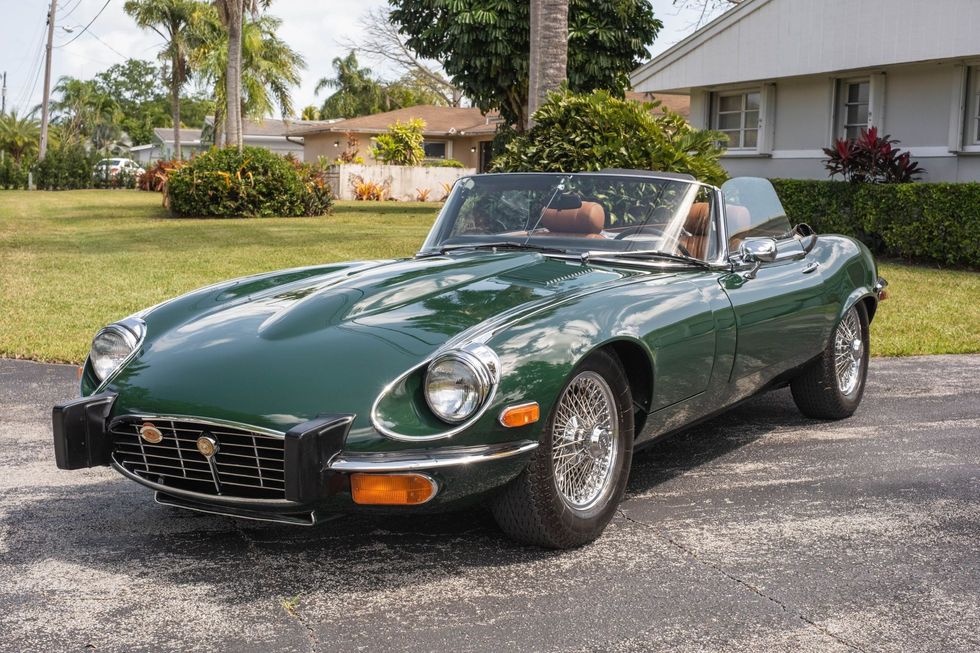
Changes implemented with the Series 3 models included an even larger front end opening with an eggcrate grille, flared wheel arches and larger rubber bumper overriders implemented on later models to meet U.S. standards.
Recent Market Performance
Enthusiasm for the E-type has persevered for more than six decades now and is reflected in the substantial value that some of these models carry today. We’ve covered recently some changes in the market the past couple of years, mainly volatility associated with a run-up during the pandemic and more recent retraction as money supply has gotten tighter. While the overall market may have reflected such a reset, it appears that the Jaguar E-type escaped any notable correction, with values largely on the rise.
Among collectors, the earliest cars with flat floors, welded louvers and the external hood latch, are considered the most valuable. Next up are the remaining Series 1 cars with covered headlamps. For drivers, the 4.2-liter cars offer a bit more oomph from under the hood. Some consider the 1967 model a sweet spot before emissions and safety regulations began changing the character of the car. Whiles Series 2 and even Series 3 cars were, for a time, less desired by collectors, as values of the earlier cars have risen, so too have values for the later cars. Particularly noticeable on Hemmings.com, we have seen the later V12-powered Series 3 models produce stronger than expected results in the past couple of years.
Jaguar E-type Performance on Hemmings.com

We looked at the sale of all Jaguar E-types on Hemmings Auctions and Hemmings Make Offer the past few years, with the results charted above. At first glance, while it appears that the prices dipped in 2022, those results included some models that may not have been as desirable, such as a coupe that had been converted to a convertible, a process almost certain to have a negative effect on the value of an XKE. Tossing out such cars from the average shows a consistent growth over the last three years.
Overall, though the sample size for 2024 is for only the first few months, we have seen a 51% growth in E-type values over the past three years, a strong result which may also reflect the quality of the cars crossing the Hemmings Auction block or being listed with Hemmings Make Offer. Thoroughly restored examples have been solid sellers on Hemmings.com.
Early E-types, like this 1963 Open Two-Seater, had extensive use of aluminum in the interior, along with rocker switches on the dashboard. Series 1.5 and later models had rocker switches in place of the toggles.
Though the values continue to show a broad picture of growth, by one metric we may be seeing a levelling off in the coming months. At Hemmings Auctions, we try to be as transparent as possible, sharing reserves when we recap our sold vehicles. When it comes to the percentage over reserve that our auction and post-auction Make Offer vehicles achieve, that number has shrunk in the past couple of years, going from a high of over 28% better than reserve on average in 2022 to a hair under 4% this year to date.
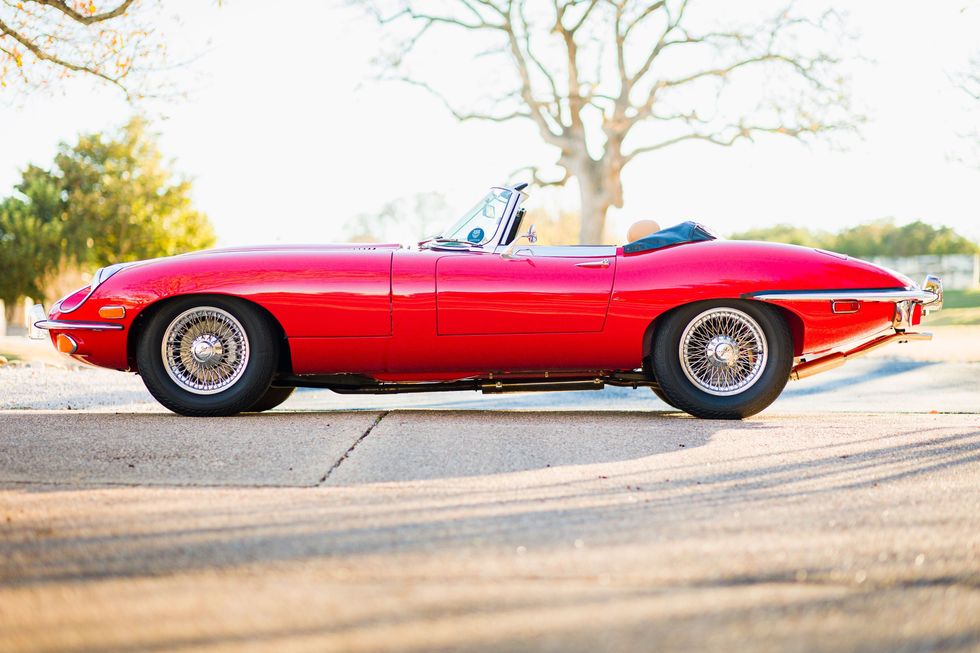
The profile view of this 1969 Jaguar E-type Series 2 Open Two-Seater shows the lines that instantly made the model famous and desired among automotive enthusiasts.
Quality Can Make a Big Difference in Value
In just about every Market Snapshot, we’ve stressed that the vehicles in the best condition tend to perform better at auction. Not only does that hold true in the case of the E-type, but perhaps on an even higher scale. The difference between a project and a driver-quality example might be, say, $25,000 versus $50,000, but the difference between a high-quality driver and a concours-ready example could vary from $75,000 to $200,000 or substantially more. There is a significant premium to be paid for the higher-quality E-types on the market.
One thing that appears to have changed in recent years is that Series 2 and now even Series 3 cars are finally getting their due with collectors. Some of this movement is undoubtedly tied to the stronger and higher prices for Series 1 cars, but some of it can be attributed to enthusiasts of these cars for their particular features, such as the V12 in the Series 3 models. In the past 12 months, Hemmings.com sold two of the highest-priced Series 3 examples that have traded hands in a public forum, including a 1974 E-type Convertible that sold for $157,500 and a 1973 E-type Convertible that resulted in a net sale price of $147,000. Both of these cars appeared to have been very thoroughly restored and presented as excellent examples.
Under the hood of Series 2 E-type, the DOHC, 4.2-liter XK engine received some changes, including a pair of Zenith-Stromberg carburetors in place of the original's triple SU setup (first seen on North American-spec Series 1.5 cars) and painted aluminum rocker covers with exposed ribs and Jaguar emblem.
Restoration Costs to Consider
Restoration costs on an E-type, it should be noted, can be breathtakingly expensive. There is a whole sub-industry of this hobby dedicated to E-type restoration on both sides of the Atlantic. “Six figures” is the common response when asking what an XKE restoration will cost. That number appears to be merely a starting point, with a whole lot of variables, including perhaps correcting an older restoration, the amount of metal needing replacement, what portion of the original parts can be salvaged, what amount of originality and patina is desired by the owner and so on. We’ve even seen stacks of receipts from our sellers indicating tens of thousands of dollars in just general refurbishment, detailing and maintenance costs prior to some cars being listed on Hemmings.com.
Factoring in restoration costs when considering an E-type works two ways. In some cases, you may need to consider restoration or refurbishment costs, while in other situations, such as bidding on a previously restored vehicle, you may be getting restoration costs at a significant discount as few restorations will return the investment by a private owner in a short period of time.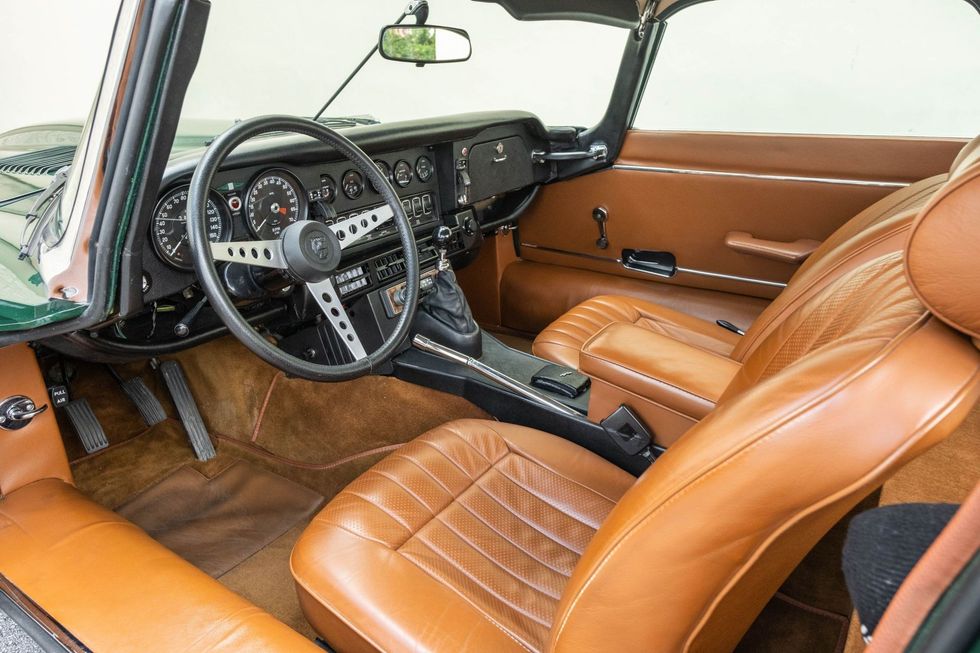
Series 3 E-types, like this 1974 convertible, had rocker switches for control gear on the dashboard and solid black trim across the instrument panel and center console.
The E-type market appears as strong as ever, with positive results for not just collectors of the earlier cars, but also Series 2 and, most noticeably, Series 3 models.
Find hundreds of collectible Jaguars on Hemmings.com!

The 5.3-liter V12 engine was standard in Series 3 E-types, including this 1974 Open Two-Seater.
1992 Lancia Delta Integrale Evo I

Miki Biasion, seen here on the 1000 Lakes (Rally Finland) in 1989, won two world titles in Lancia Deltas.
Photo: Lancia
Let’s kick things off with a World Rally Championship (WRC) great. Lancia had already established its rallying dynasty via the Fulvia, Stratos and Rally 037 by the time the Delta arrived on the scene in 1985. The initial S4 Group B monster gave way to the production-based Group A machines at the end of the following season, with several iterations of the boxy five-door produced as homologation specials. The resulting AWD, turbocharged Delta HFs and Integrales kept Lancia at the sharp end until 1992, collecting six consecutive drivers’ and manufacturers’ championships from 1987-92.





1965 Austin Mini Cooper

Paddy Hopkirk's 1964 Monte Carlo victory in the Mini Cooper S was a landmark in Mini’s history.
Photo: Mini
The ultimate underdog, the Mini Cooper continues to embarrass far larger, more powerful cars in motorsports competition to this day. Back in the 1960s, the John Cooper-tuned machine cemented its legacy of timeless, classless appeal with a string of rally victories. Two outright wins on the Monte Carlo Rally – for Paddy Hopkirk in 1964 and Rauno Aaltonen in 1967 – were the highlights, with a third controversially denied the British Motor Corporation’s Competitions Department by the French organizers in 1966.





1965 Ford Mustang

Swedish driver Bo “Bosse” Ljungfeldt at speed in an Alan Mann-prepared Ford Mustang during the 1964 Tour de France Automobile.
Photo: Ford Motor Company
Like the Mini Cooper, the then-new Ford Mustang benefited from an image boost thanks to early motorsport engagements. The first was an entry in the 1964 Tour de France Automobile. Three red coupes were entered by Alan Mann Racing on behalf of Ford and a fourth by Ford of France. As detailed in a Hemmings article, two of the Holman-Moody 289-engined cars finished eighth and ninth overall, first and second in class.





1993 Mitsubishi Lancer EVO I

Four-time WRC champion, Tommi Mäkinen aboard a Mitsubishi Evo VI (1999).
Photo: Mitsubishi
Mitsubishi Lancer Evolutions (commonly referred to as "Evos") dominated the WRC stages in the late-1990s, propelling Tommi Mäkinen to four straight drivers’ titles from 1996-'99. Mitsubishi’s rapid advances in 4WD technology were at the heart of its dominance. Building on the Galant VR-4’s viscous-coupling center differential, engineer Dr. Kaoru Sawase pioneered an electronically controlled, center-diff four-wheel drive system in 1992 and followed it up four years later with the active yaw control (AYC) differential that made its debut in the Lancer Evolution IV, which took Mäkinen to his first championship.




1986 Porsche 911

Reigning champion Walter Röhrl drove a 911 SC on Rally San Remo in 1981.
Photo: Porsche
It’s perhaps more famous as a track racer, but the 911’s history in rallying is almost as old as the car itself. It finished fifth on the 1965 Monte Carlo Rally just four months after it went on sale. Vic Elford’s 911 SC 2.0 later scored a victory there in 1968, with Björn Waldegård repeating the feat in the following two years. Much later, in the 1980s, a 4WD 911 was developed for rallying, winning the Paris-Dakar in 1984 and paving the way for the Group B 959, in which René Metge won again, two years later.





1979 Škoda 120 L

John Haugland’s Ulster Rally 130 LR from 1987. Twenty were built by the factory for racing, with another 200 to meet the homologation quota.
Photo: Škoda
Delta, Quattro, Peugeot 205 T16…Škoda? The rear-engined Czech sedan is not top of most people’s list when it comes to naming the great cars of the Group B era, but the Škoda 130 LR had its giant-killing moments and developed a cult following among rally fans.
Škoda’s rally tradition was well established by the time the 130-bhp, 730-kg 130 LR arrived in 1985, and continues to this day. In the hands of drivers like Ladislav Křeček and John Haugland, the unfancied 130 LR finished well inside the top-20 on WRC events, with Křeček securing an amazing sixth overall on the San Remo in 1986, when several leading runners failed to make the finish.




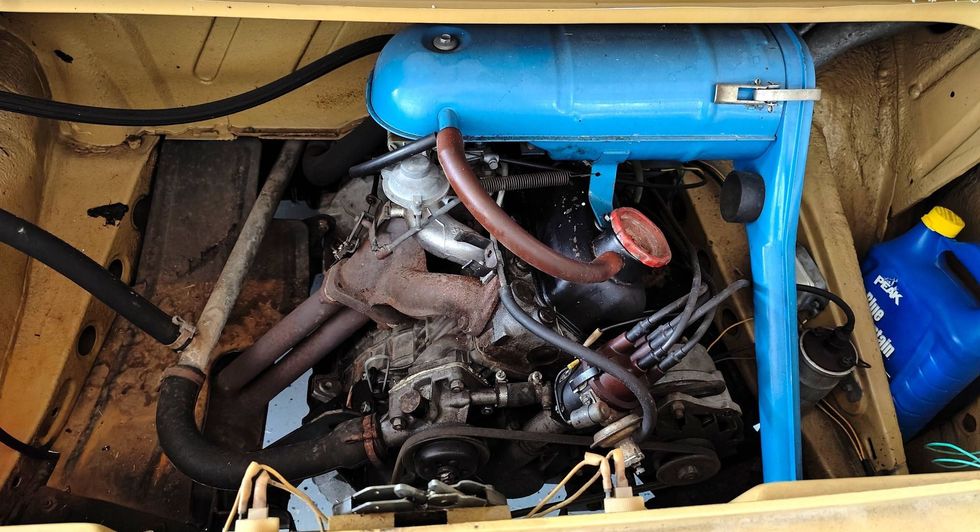
1952 Jaguar XK120

Ian and Patricia Appleyard’s legendary NUB 120 is still seen regularly at classic car events.
Photo: Jaguar Heritage Trust
Probably the most famous of all race or rally XK 120s was NUB 120. This 1950 machine won an Alpine Rally Gold Cup for three consecutive, penalty-free runs from 1950-52 in the hands of privateer owner-driver, Ian Appleyard – navigated by his wife Patricia, daughter of Jaguar founder William Lyons. The pair counted two outright Alpine Rallies as well as the RAC Rally and the Tulip Rally among a string of victories in an incredible three-year period. This historic car has been back with its maker since it was replaced by another in 1953, but still participates in classic events.





1973 Mercedes-Benz 450 SLC Rally Tribute

In 1980 Björn Waldegård and Hans Thorszelius won the 12th Bandama Rally in Ivory Coast in a 500 SLC. It was Mercedes’ final works rally entry to date.
Photo: Mercedes-Benz
Mercedes-Benz is not synonymous with rallying but has a long tradition in the sport, especially in long-distance endurance events. In 1959, for example, driver-turned-Mercedes-sports-director Karl Kling won the Rallye Mediterranée-Le Cap, from the Mediterranean to South Africa, in a Mercedes-Benz 190 D (W 121). In 1963, Eugen Böhringer won the Liège-Sofia-Liège Rally in a 230 SL Pagoda (W 113) and in ’77, Andrew Cowan and Anthony Fowkes won the London-Sydney Marathon in 280 E (W 123). Two years later, a 450 SLC (C 107) won the Bandama Rally on the Ivory Coast, with Björn Waldegård (him again) repeating the feat in a 500 SLC the following year.





1983 Audi Quattro Coupe

Audi clinched its first World Rally Championship for Manufacturers with the Quattro in 1982.
Photo: Audi
This is the car that set the template for the modern era of turbocharged, four-wheel drive rally cars. Quattros secured a couple of manufacturers’ championships in the WRC before, the first of them at the end of the Group 4 era in 1982. The Ur-Quattro (original Quattro) was first upgraded to A1, then A2 spec and then shortened to create the wild Sport Quattro to battle new Group B competitors from Peugeot and Lancia.





2002 Subaru Impreza WRX

2003 World Champion Petter Solberg on his way to third place on the 2004 Rally Sweden driving a Subaru Impreza WRC2003.
Photo: Subaru
The fan-favorite, blue-and-gold Subaru Legacys and Imprezas were a fixture of the WRC in the 1990s and 2000s. The Prodrive-run Subaru World Rally Team won three drivers’ and three manufacturers’ titles, and transformed the image and sales performance of the Japanese brand. Twenty years later, its cars are still winning U.S. rallies in the ARA championship.





